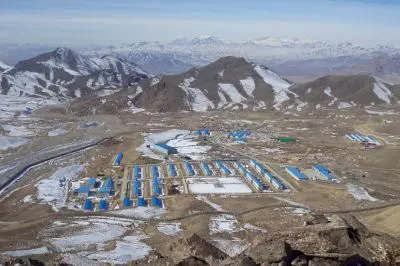On October 5, 2018, in Washington, DC, Afghan officials signed a 30-year contract with the Center Investment Group and its operating company, the Afghan Gold and Minerals Company, to explore and develop copper mining operations in the Balkhab area of Sar-e-Pul province

Afghanistan possesses vast mineral resources estimated to be worth between $1 trillion and $3 trillion. These resources include precious and semi-precious Stones such as lapis lazuli, emeralds, rubies, and sapphires. The country also has substantial deposits of industrial Minerals like talc and marble, as well as valuable Metals like copper, iron ore, and gold. Furthermore, Afghanistan is believed to hold significant deposits of lithium, rare earth elements, natural gas, oil, and coal.
However, the development and exploitation of these resources face numerous challenges. Ongoing conflict and security concerns in Afghanistan have hindered mining operations, making it difficult for both local and foreign companies to operate safely. Inadequate infrastructure, including transportation networks and power supplies, poses additional challenges for mining activities. The regulatory environment is still evolving, with issues of corruption, lack of transparency, and inconsistent enforcement impacting investor confidence. Afghanistan also lacks local expertise and technology required for large-scale mining operations, necessitating partnerships with foreign entities.
Afghanistan has abundant natural resources including vast reserves of natural gas, oil, coal, marble, gold, copper, chromite, talc, barite, sulfur, lead, zinc, iron ore, salt, precious and semi-precious stones, and many more. In 2006, a US geological survey estimated that Afghanistan had 36 trillion cubic feet of natural gas and 3.6 billion barrels of oil and condensate reserves. According to a 2007 assessment, Afghanistan has a significant amount of undiscovered mineral resources. Geologists also found evidence of abundant deposits of colored stones and precious stones, including emeralds, rubies, sapphires, garnets, azure, composite, spinel, tourmaline, and peridot.
In 2010, US Pentagon officials, along with US geologists, uncovered approximately $ 1 trillion in untapped mineral reserves in Afghanistan. A Pentagon note says Afghanistan could become Saudi Arabia's lithium. Some believe that intact minerals are worth up to $ 3 trillion. Another US Geological Survey in September 2011 estimated that household carbonates in Helmand province were estimated to contain 1 million tonnes of trace elements. "This is just another piece of evidence that shows Afghanistan's mining sector has a bright future," said Regina Dubai, head of the Department of Defense's Special Task Force (TFBSO).
Afghanistan signed a Copper deal with China (China Metallurgical Co., Ltd.) in 2008. It is a large project involving $ 2.8 billion in Chinese investment and about $ 400 million in annual revenue for the Afghan government. The Aynak copper mine, located in Logar province, is one of the largest in the world and is expected to provide jobs for 20,000 Afghans. It is estimated to have at least 11 million tons, or $ 33 billion, of copper.
On October 5, 2018, in Washington, DC, Afghan officials signed a 30-year contract with the Center Investment Group and its operating company, the Afghan Gold and Minerals Company, to explore and develop copper mining operations in the Balkhab area of Sar-e-Pul province. And to explore and develop a gold mining operation in Badakhshan province. The copper contract included an investment of $ 56 million and the gold contract $ 22 million.
Experts believe that copper production could start in two to three years and iron ore in five to seven years from 2010. Another recently announced treasure is the Hajigak iron ore mine, located 130 miles west of Kabul, which is believed to hold about 1.8 billion to 2 billion metric tons of the mineral used to make steel. AFISCO, an Indian consortium of seven companies led by the Indian Steel Authority and Goldmines Canada, is expected to jointly invest $ 14.6 billion in the development of the Hajigak iron ore mine. The country has several Coal mines but needs to be modernized.
In conclusion, Afghanistan's mineral wealth presents significant opportunities for economic development. However, overcoming security risks, infrastructural deficiencies, regulatory issues, and environmental concerns is crucial. With the right investments and international cooperation, the mining sector has the potential to play a pivotal role in Afghanistan's economic future.
Environmental concerns related to mining activities, such as water contamination and land degradation, need to be addressed through effective environmental management practices. Despite these challenges, the Afghan government has been actively working to attract foreign investment in the mining sector by offering incentives and improving the regulatory framework. International organizations and countries have provided assistance in mapping and developing Afghanistan's mineral resources, aiding in their identification and quantification. Public-private partnerships are encouraged to leverage government support and private sector efficiency, with the mining sector seen as a potential driver for economic growth and job creation.






